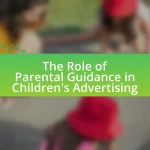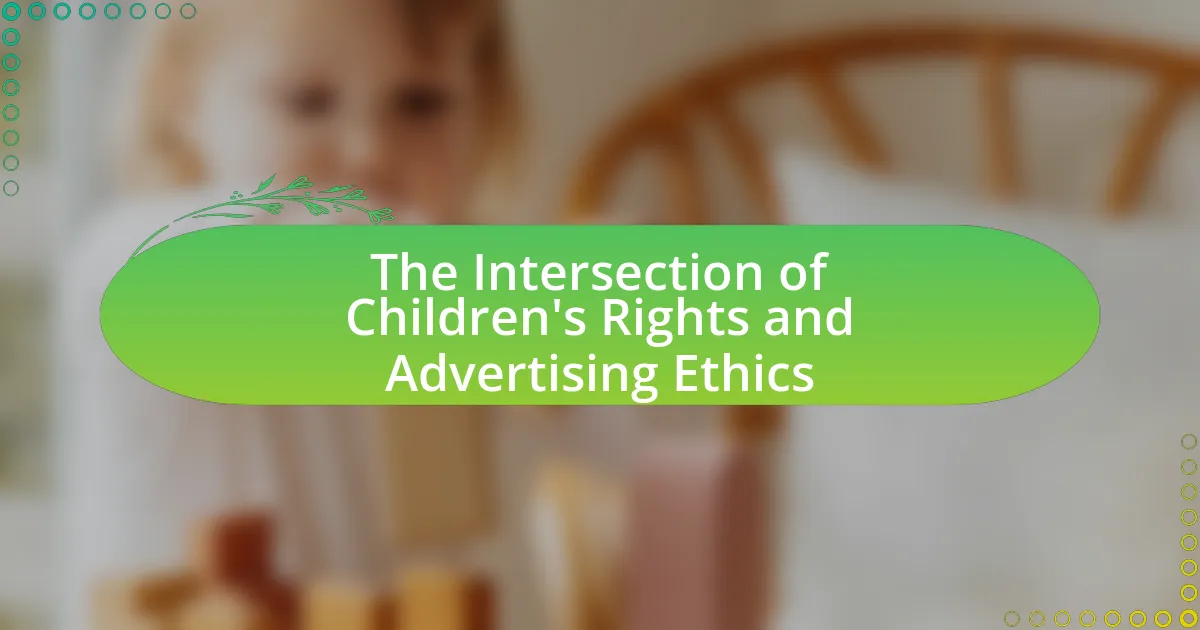The article focuses on the effectiveness of current advertising standards for children’s products, highlighting the regulations designed to protect young audiences from misleading marketing practices. It examines the roles of various organizations, such as the Federal Trade Commission (FTC) and the Children’s Advertising Review Unit (CARU), in establishing and enforcing these standards. Key criteria for evaluating compliance, the importance of ethical advertising, and the potential risks children face from deceptive advertisements are discussed. Additionally, the article addresses challenges in enforcement, the impact of digital marketing, and suggests improvements to enhance the protection of children’s rights and well-being in advertising.
What are the Current Advertising Standards for Children’s Products?
The current advertising standards for children’s products are primarily governed by regulations that aim to protect children from misleading or harmful marketing practices. In the United States, the Federal Trade Commission (FTC) enforces guidelines that require advertisements to be truthful, not misleading, and substantiated, particularly when targeting children. Additionally, the Children’s Online Privacy Protection Act (COPPA) imposes restrictions on the collection of personal information from children under 13, influencing how products are marketed online. In the European Union, the Audiovisual Media Services Directive (AVMSD) sets similar standards, prohibiting advertisements that exploit children’s inexperience or credulity. These regulations are designed to ensure that advertising directed at children is responsible and does not encourage unhealthy behaviors or unrealistic expectations.
How are these standards defined and regulated?
Advertising standards for children’s products are defined and regulated through a combination of governmental regulations, industry guidelines, and self-regulatory bodies. In the United States, the Federal Trade Commission (FTC) establishes rules to protect children from misleading advertising, while organizations like the Children’s Advertising Review Unit (CARU) provide additional oversight and guidelines specific to children’s marketing. These standards are informed by research on child development and consumer behavior, ensuring that advertisements are appropriate and not exploitative. For instance, the Children’s Online Privacy Protection Act (COPPA) regulates the collection of personal information from children under 13, reinforcing the importance of ethical advertising practices.
What organizations are responsible for establishing these standards?
The organizations responsible for establishing advertising standards for children’s products include the Federal Trade Commission (FTC) in the United States, the Advertising Standards Authority (ASA) in the United Kingdom, and the Children’s Advertising Review Unit (CARU). The FTC enforces regulations to protect children from deceptive advertising practices, while the ASA sets guidelines for responsible advertising in the UK. CARU specifically focuses on reviewing advertising directed at children to ensure compliance with established standards. These organizations play a crucial role in shaping and enforcing advertising practices to safeguard children’s interests.
What criteria are used to evaluate compliance with these standards?
Compliance with advertising standards for children’s products is evaluated based on criteria such as truthfulness, appropriateness, and clarity of the message. Truthfulness ensures that claims made in advertisements are accurate and not misleading, which is crucial given the vulnerability of children to deceptive marketing. Appropriateness assesses whether the content is suitable for the target age group, avoiding themes that may be harmful or confusing to children. Clarity focuses on how easily children can understand the advertisement, ensuring that the language and visuals are age-appropriate. These criteria are essential for protecting children from exploitation in advertising and are often enforced by regulatory bodies through guidelines and monitoring practices.
Why are advertising standards important for children’s products?
Advertising standards are crucial for children’s products to ensure that marketing practices are ethical and do not exploit the vulnerability of young audiences. These standards protect children from misleading claims, inappropriate content, and excessive commercialization, which can negatively impact their development and well-being. For instance, research by the American Psychological Association indicates that children are particularly susceptible to persuasive advertising techniques, making it essential to have regulations that limit such practices. By enforcing advertising standards, regulatory bodies help create a safer environment for children, promoting healthier consumption habits and fostering critical thinking skills regarding media messages.
What potential risks do children face from misleading advertisements?
Children face several potential risks from misleading advertisements, including the development of unrealistic expectations, unhealthy lifestyle choices, and financial exploitation. Misleading advertisements often portray products in a way that exaggerates their benefits or misrepresents their effectiveness, leading children to believe they will achieve certain outcomes that are not realistic. For instance, studies have shown that children exposed to advertisements for unhealthy foods are more likely to choose those products, contributing to poor dietary habits and obesity. Additionally, children may be persuaded to spend their allowance or parents’ money on products that do not deliver as promised, resulting in financial exploitation. The Federal Trade Commission has noted that children are particularly vulnerable to deceptive marketing practices due to their limited ability to critically evaluate advertisements.
How do advertising standards protect children’s rights and well-being?
Advertising standards protect children’s rights and well-being by regulating the content and delivery of advertisements aimed at minors. These standards ensure that advertisements do not exploit children’s inexperience or credulity, thereby safeguarding them from misleading claims and harmful products. For instance, the Children’s Advertising Review Unit (CARU) guidelines prohibit advertisements that could encourage unhealthy eating habits or promote unsafe products to children. Research indicates that strict adherence to these standards has led to a decrease in the prevalence of unhealthy food advertising directed at children, contributing to better health outcomes.

How Effective are the Current Advertising Standards?
Current advertising standards for children’s products are moderately effective, primarily due to their ability to limit misleading claims and promote transparency. These standards, enforced by regulatory bodies such as the Federal Trade Commission in the United States, require that advertisements for children’s products be truthful and not exploit children’s inexperience. For instance, a 2021 report by the American Psychological Association highlighted that compliance with these standards has led to a reduction in deceptive advertising practices, indicating a positive impact on consumer protection. However, challenges remain, such as the rapid evolution of digital marketing strategies that can circumvent traditional regulations, suggesting that while current standards are beneficial, they require ongoing updates to maintain effectiveness.
What metrics are used to measure the effectiveness of these standards?
The metrics used to measure the effectiveness of advertising standards for children’s products include compliance rates, consumer awareness levels, and impact assessments on children’s behavior. Compliance rates indicate how well advertisers adhere to established standards, with studies showing that higher compliance correlates with reduced misleading advertisements. Consumer awareness levels are assessed through surveys that gauge parents’ understanding of advertising regulations, revealing that increased awareness leads to more informed purchasing decisions. Impact assessments evaluate changes in children’s purchasing behavior and attitudes towards products, with research indicating that stricter advertising standards can lead to healthier consumption patterns among children.
How do surveys and studies assess public perception of advertising standards?
Surveys and studies assess public perception of advertising standards by collecting quantitative and qualitative data from diverse demographic groups regarding their views on advertising practices. These assessments often utilize structured questionnaires and interviews to gauge awareness, attitudes, and beliefs about the ethicality and effectiveness of advertising standards. For instance, a study conducted by the American Psychological Association in 2020 found that 75% of parents expressed concerns about the appropriateness of advertisements targeting children, highlighting a significant public sentiment regarding advertising standards. This data is then analyzed to identify trends and inform policymakers about the public’s expectations and perceptions, ultimately influencing the development and enforcement of advertising regulations.
What role does compliance monitoring play in evaluating effectiveness?
Compliance monitoring plays a critical role in evaluating effectiveness by ensuring that advertising standards for children’s products are adhered to. This process involves systematic checks and assessments of marketing practices against established regulations, which helps identify areas of non-compliance and potential risks to children’s welfare. For instance, studies have shown that effective compliance monitoring can lead to a significant reduction in misleading advertisements, thereby enhancing the overall integrity of advertising practices. By tracking adherence to standards, organizations can measure the impact of regulations on consumer protection and the effectiveness of advertising strategies aimed at children.
What challenges exist in enforcing advertising standards for children’s products?
Enforcing advertising standards for children’s products faces significant challenges, primarily due to the rapid evolution of digital marketing and the diverse platforms used to reach children. Regulatory bodies often struggle to keep pace with new advertising techniques, such as influencer marketing and social media ads, which can easily bypass traditional regulations. Additionally, the subjective nature of what constitutes appropriate content for children complicates enforcement, as cultural differences and varying parental expectations influence perceptions of advertising appropriateness. Studies indicate that children are particularly vulnerable to persuasive advertising tactics, making it crucial for standards to be effectively enforced to protect their interests. However, the lack of uniformity in regulations across different jurisdictions further complicates the enforcement process, leading to inconsistencies in how advertising standards are applied globally.
How do loopholes in regulations affect the enforcement of standards?
Loopholes in regulations significantly undermine the enforcement of standards by allowing companies to exploit gaps in legal frameworks. For instance, when regulations lack specificity, businesses can circumvent compliance by interpreting the rules in a manner that aligns with their interests, thereby diluting the intended protective measures. A study by the Federal Trade Commission in 2019 highlighted that vague advertising standards for children’s products led to misleading marketing practices, which ultimately compromised the safety and well-being of children. This demonstrates that without stringent and clearly defined regulations, the enforcement of standards becomes ineffective, allowing harmful practices to persist.
What are the consequences of non-compliance for advertisers?
Non-compliance for advertisers can lead to significant legal and financial repercussions. Advertisers may face fines, penalties, or lawsuits from regulatory bodies for violating advertising standards, particularly those aimed at protecting children. For instance, the Federal Trade Commission (FTC) enforces regulations that prohibit misleading advertising, and violations can result in fines reaching thousands of dollars per incident. Additionally, non-compliance can damage an advertiser’s reputation, leading to loss of consumer trust and potential declines in sales. In extreme cases, repeated violations may result in restrictions on future advertising practices or even the revocation of licenses to operate in certain markets.

What Improvements Can Be Made to Current Advertising Standards?
Improvements to current advertising standards for children’s products can include stricter regulations on misleading claims and enhanced transparency regarding product safety. Stricter regulations can prevent advertisements that exaggerate benefits or downplay risks, ensuring that children and their guardians receive accurate information. Enhanced transparency can involve clear labeling of age appropriateness and potential hazards, which is crucial given that children are particularly vulnerable to persuasive marketing tactics. Research indicates that children are less able to critically evaluate advertising messages, making it essential to implement these improvements to protect their interests and promote informed decision-making among parents.
How can advertising standards be updated to reflect modern marketing practices?
Advertising standards can be updated to reflect modern marketing practices by incorporating digital transparency, data privacy regulations, and ethical guidelines for influencer marketing. Digital transparency ensures that advertisements are clearly labeled, especially in social media contexts where sponsored content can be misleading. Data privacy regulations, such as the General Data Protection Regulation (GDPR), mandate that advertisers disclose how consumer data is collected and used, fostering trust. Ethical guidelines for influencer marketing can help prevent deceptive practices, ensuring that endorsements are genuine and not misleading to children. These updates are essential as they align with the evolving landscape of advertising, where digital platforms dominate and consumer awareness is heightened.
What role does digital advertising play in shaping new standards?
Digital advertising plays a crucial role in shaping new standards by influencing consumer behavior and setting benchmarks for marketing practices. The rapid growth of digital platforms allows advertisers to reach targeted audiences effectively, leading to the establishment of new norms regarding transparency, engagement, and ethical considerations in advertising. For instance, the rise of social media influencers has prompted brands to adopt more authentic and relatable marketing strategies, which has redefined consumer expectations and industry standards. Additionally, regulatory bodies are increasingly focusing on digital advertising practices, as seen in the Federal Trade Commission’s guidelines on advertising to children, which emphasize the need for clear disclosures and responsible messaging. This evolving landscape demonstrates how digital advertising not only adapts to but also actively shapes the standards governing advertising practices, particularly in sensitive areas like children’s products.
How can stakeholder collaboration enhance the effectiveness of standards?
Stakeholder collaboration enhances the effectiveness of standards by integrating diverse perspectives and expertise, which leads to more comprehensive and relevant guidelines. When stakeholders, including manufacturers, regulators, and consumer advocates, work together, they can identify gaps in existing standards and address specific needs, ensuring that the standards are practical and applicable in real-world scenarios. For instance, the collaboration between the Federal Trade Commission and child advocacy groups has resulted in more stringent advertising standards that protect children from misleading marketing practices. This collaborative approach not only improves the quality of the standards but also fosters trust and compliance among all parties involved, ultimately leading to better protection for children in advertising contexts.
What best practices should advertisers follow to comply with standards?
Advertisers should ensure transparency, accuracy, and appropriateness in their messaging to comply with advertising standards. This includes providing clear information about the product, avoiding misleading claims, and ensuring that content is suitable for the target audience, particularly children. For instance, the Children’s Advertising Review Unit (CARU) guidelines emphasize that advertisements directed at children should not exploit their credulity or lack of experience. Compliance with these standards is essential to foster trust and protect vulnerable audiences, as evidenced by the Federal Trade Commission’s enforcement actions against misleading advertising practices.
How can advertisers ensure transparency and honesty in their messaging?
Advertisers can ensure transparency and honesty in their messaging by adhering to clear guidelines and regulations that promote truthful communication. Implementing standards such as the American Advertising Federation’s Code of Advertising Ethics requires advertisers to avoid misleading claims and provide accurate information about their products. Additionally, utilizing third-party verification services can enhance credibility by validating claims made in advertisements. Research indicates that 73% of consumers are more likely to trust brands that are transparent about their practices, highlighting the importance of honesty in building consumer trust.
What strategies can be implemented to engage parents and guardians in advertising?
To engage parents and guardians in advertising, brands can implement strategies such as creating relatable content that addresses their concerns and values. For instance, using testimonials from other parents can build trust and credibility, as studies show that 92% of consumers trust recommendations from friends and family over any other form of advertising. Additionally, offering educational resources or workshops related to children’s products can foster a sense of community and involvement, making parents feel more connected to the brand. Engaging parents through social media platforms where they actively participate can also enhance interaction, as 70% of parents report using social media to seek parenting advice.
What are the future trends in advertising standards for children’s products?
Future trends in advertising standards for children’s products will increasingly emphasize transparency, ethical marketing practices, and the protection of children’s privacy. Regulatory bodies, such as the Federal Trade Commission (FTC) in the United States, are likely to implement stricter guidelines that require advertisers to disclose the nature of their marketing strategies, particularly in digital platforms where children are highly engaged. Additionally, there is a growing movement towards limiting the use of persuasive techniques that exploit children’s developmental vulnerabilities, as highlighted by research from the American Psychological Association, which advocates for more responsible advertising practices. These trends reflect a broader societal shift towards prioritizing children’s well-being and ensuring that advertising is not misleading or harmful.
How might technology influence the evolution of advertising standards?
Technology will significantly influence the evolution of advertising standards by enabling more precise targeting and data-driven strategies. The rise of digital platforms allows advertisers to collect and analyze consumer data, leading to tailored advertising that meets specific audience needs. For instance, the use of artificial intelligence in analyzing user behavior can help create more effective and compliant advertisements, particularly for children’s products, ensuring that they adhere to ethical standards. Additionally, advancements in technology, such as augmented reality and interactive content, can enhance engagement while necessitating updated regulations to protect vulnerable audiences. These developments highlight the need for evolving standards that address both the capabilities of new technologies and the ethical implications of their use in advertising.
What emerging issues should be addressed in future regulations?
Emerging issues that should be addressed in future regulations include the impact of digital marketing on children’s products and the ethical implications of data collection from minors. As children increasingly engage with digital platforms, regulations must adapt to ensure that advertising practices do not exploit their vulnerability. For instance, a study by the American Psychological Association highlights that children are particularly susceptible to persuasive advertising techniques, necessitating stricter guidelines to protect them from misleading claims. Additionally, the rise of targeted advertising based on data analytics raises concerns about privacy and consent, emphasizing the need for regulations that safeguard children’s personal information.






